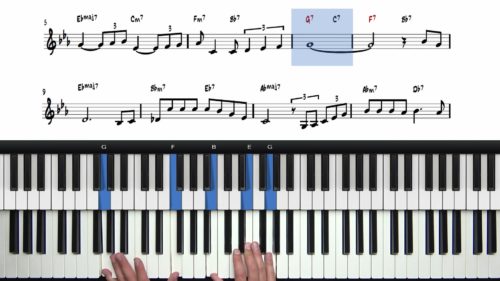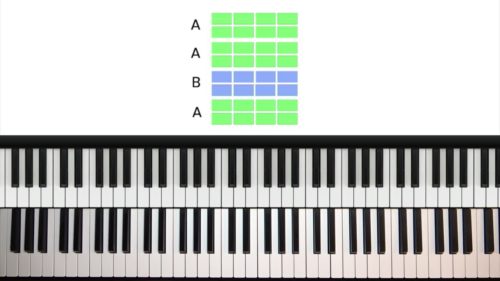Turnarounds For Beginners
In this lesson we introduce the concept of the turnaround. The turnaround is typically the final two bars in the blues form and it’s used to lead smoothly and convincingly back to the top of the form.
Why Is The Turnaround Important?
Well, the blues is a cyclical chord progression in the sense that it is repeated many times during a single performance and so smoothly transitioning back to the top of the form is an important skill.
If we play the exact same turnaround voicings each time we arrive at the end of the form, our playing can start to sound repetitive and so this module will teach you many variations and permutations of the turnaround.
Left Hand Embellishments
We have several options in the left hand when playing turnarounds. One option is simply to play single bass notes walking up from the I to the V chord. Notice the chromatic passing tone “B” between the IV and the V chords:

We can also play octaves in the bass for a thicker sound and grace notes can be used to add ornamentation and additional interest to our left hand. All of these techniques can then be combined to create interesting turnaround passages.
Blues Turnaround Variations
There are a potentially infinite number of ways that we can navigate the turnaround section of the blues. In this lesson we start with a the most basic turnaround examples. Another useful movement is descending 3rd in the right hand melody:

In the next lessons we explore a range of options and techniques that incorporate blues scales, extended chords, altered chords, gospel chord progressions, and more.
Lesson Downloads
-
Basic Blues Turnarounds File Type: pdf
Practice Tips
-
The turnaround sequence typically incorporates both chromatic and step-wise bass line movement from the I chord to the V chord.
-
Try to visualise the ascending bass line and outline this movement with single note bass, octave bass, and also add embellishments using grace notes.
-
Familiarise yourself with the different options that we have for the V7 chord in bar 12. The F/C moving to C7#5 can be used, or alternatively the descending line using 3rd intervals.
-
Start a habit of spontaneously choosing between these subtle turnaround variations to add more interest and variety to your blues piano playing.
-
Once you are comfortable with the basic versions of the turnaround outlined in this lesson, move onto the next lessons in this module.







